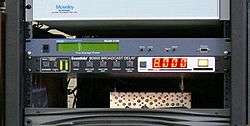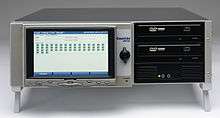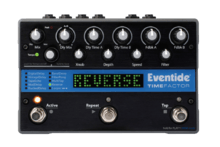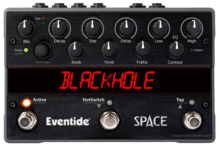Eventide, Inc
|
| |
| Corporation | |
| Founded | 1971 |
| Headquarters | Little Ferry, New Jersey |
Key people |
Richard Factor, Co-founder and Chairman Orville Greene, Co-founder Steve Katz, Co-founder Anthony Agnello, President, Audio Division Richard Van Tieghem, President, Communications Division |
| Products | Pro Audio, Communications, and Avionics equipment and software |
| Website | www.eventide.com |

Eventide, Inc. (also known earlier as Eventide Clock Works Inc., or today simply Eventide) is an audio and broadcast, communications, and avionics company in the United States whose audio division manufactures digital audio processors and DSP software, and guitar effects. Eventide was one of the first companies to manufacture digital audio processors, and its products are mainstays in Sound recording and reproduction, post production, and broadcast studios.[1]
Beginnings
Eventide was founded by recording engineer Stephen Katz, inventor Richard Factor, and businessman/patent attorney Orville Greene. The business was founded in the basement of the Sound Exchange, a recording studio located at 265 West 54th Street in New York City and owned by Greene. When Katz needed to rewind the analog tape back to a specific point on their Ampex MM1000 multitrack recorder, but limited space in the studio did not allow for a tape op (a person who were operating the tape recorders by the orders of the sound engineer), Katz asked Factor to build a gadget that would do the job, and the resulting device turned into an Original equipment manufacturer (OEM) success for Ampex. Other early products included a two-second delay for telephone research and an electrostatic deflector for dispensing nanoliter quantities of chemical reagents.
Eventide's original product line consisted of two products: the Instant Phaser (the result of an AES Show appearance), and what would become the 1745 Digital Delay Line (the result of a significant order from Maryland Public Broadcasting).
Beginning with the 1745M, Eventide began widely using Random-access memory (RAM) chips in many of their products. After purchasing a Hewlett-Packard computer for researching reverb algorithms and needing to upgrade the memory in order for the computer to handle the necessary complex computations, Eventide designers realized that they could manufacture computer memory expansion far more affordably than the current market price. Therefore, Eventide began to manufacture and sell HP-compatible RAM expansion boards and did so from the late 1970s to the mid-1990s.[2]
Aviation
Shortly after Eventide moved its offices from Manhattan to New Jersey, its President earned a private airplane pilot's license. Surprised that moving map displays were not available for small airplanes, he had Eventide develop Argus, the first moving map system, and one of the first multi-function displays designed for general aviation use.[3]
Digital Logging

In the early 1990s, Eventide developed digital logging machines that enabled broadcasters to begin archiving digitally with improved audio quality and far greater storage capabilities (via DAT and later DVD-RAM) than they previously had been working with.
Eventide offers advanced Communications Logging Recorders and Instant Recall Recorders for P25, NG911, Public Safety, Utilities, and Air Traffic Control facilities. The NexLog mission-critical communications logging systems capture, store, protect, reproduce, and manage important interactions and critical data.
H910 Harmonizer
The Eventide H910 Harmonizer was first demonstrated to universally positive reactions at the AES show in late 1974. It was designed by Eventide's first engineer, Tony Agnello (who went on to become the president of Eventide's audio division). The pre-production prototype was a hand-wired box topped with a music keyboard controller. Jon Anderson of the band Yes was among those impressed, and he became a tester for the first prototype. The production H910 was released in 1975, offering pitch shifting (±1 octave), delay (up to 112.5 ms), feedback regeneration and other features in an easy-to-use box that sold for $1,600. The H910 was named after a Beatles tune (the model number refers to the "One After 909").
The first H910 customer was New York City's Channel 5, utilizing it to downward pitch shift I Love Lucy reruns that were sped up to create room to run more commercials. Speeding up the reruns had increased the pitch of the audio, and the H910 was able to shift that pitch back to where it originally had been. Frank Zappa added it to his guitar processing rig. Producer Tony Visconti used the H910 to create the snare sound on David Bowie's album Low (1977), as did Tony Platt on AC/DC's song "Back in Black" (1980). Another popular application was to use two H910s slightly detuned with a small delay. Notable users of this twin Harmonizer effect included Eddie Van Halen, who used it for his trademark guitar sound, and Tom Lord-Alge, who used it for the vocals on the hit Steve Winwood song, "Back in the High Life Again" (1986). Recognizing the popularity of this application, Eventide later recreated it as the "Dual 910" program in the H3000 UltraHarmonizer released in the late 1980s.
The H910 Harmonizer was recognized by the AES with a TECnology Hall of Fame award in 2007,[4] and on November 10, 1976, Eventide filed a trademark registration for "Harmonizer," and Eventide continues to maintain its rights to the Harmonizer trademark today.[5]
Timeline of noteworthy products


- 1745 Digital Delay Line - 2-channels of independent delay from a single input, with the delays ranging from 0 to 200 milliseconds.
- 1745A Digital Delay Line - Modification of 1745 DDL with easier, more user-friendly shift registers.
- 1745M - Another variant of the original 1745M, this version was one of the first uses of Random Access Memory (RAM) in an audio product, and also had an optional pitch change module, one of the first products of this kind with a frequency response suitable for music.
- H910 Harmonizer® (1975) - First commercially available pitch changer.
- H949 Harmonizer® - Harmonizer with finely controllable pitch change capability, used for "doubling" vocals, and "deglitch" option for greatly reducing objectionable artifacts in harmonized audio.
- BD955 (1975) - "Obscenity Delay" allowed broadcasters sufficient delay to delete any objectionable content (like from a live telephone caller on a radio show) with no apparent interruption to the program. It was the successor to a custom 1 1/4 second delay built for WPLJ NY 95.5 which was the first electronic delay for broadcast. Later ABC also commissioned a five minute custom delay used to delay the radio network news.
- SP2016 - Early Digital Reverb processor utilizing DSP and first effects device to publish its SDK so that 3rd party developers could develop "plug-in" algorithms
- Instant Phaser™ - The first phaser
- Instant Flanger™ - One of the first flangers
- H3000 (1986) - First intelligent/diatonic pitch shifting.
- DSP4000 (1994)[6][7] - User-programmable algorithms with a large toolkit of DSP functions
- DSP4000B, DSP4000B+ - Series of processors with algorithms written for broadcast and film production, by sound designer Jay Rose.
- DSP4500 (1998)[8] - Similar to DSP4000 with the addition of sampling
- DSP7000 (2001)[9] - Pitch shifter / effects processor with four times more processing power than the DSP4000 series
- DSP7500 (2001) - Similar to DSP7000 with the addition of sampling
- Orville (2001)[10][11] - Pitch shifter / effects processor with twice the processing power of the DSP7000 / DSP7500 processors[12][13] and up to 8 channels
- Eclipse (2002)[14][15][16]
- Clockworks Legacy (2003) - Software plug-in versions of classic Eventide effects and DSP[17]
- BD500 (2004) - 40-second version of Eventide's fourth-generation broadcast profanity delay[18]
- Anthology TDM Bundle (2005)[19]
- H8000FW (2005)[20] - Successor to Orville with increased processing power
- H7600 (2006)[21] - Successor to the DSP7000 series with increased processing power

- Stompbox Line (2007) TimeFactor, ModFactor, Pitchfactor, Space, H9, Powerfactor.[22]
References
- ↑ Sound On Sound, "Astral Tweaks: Eventide Eclipse Multi-effects," Sep 2001, http://www.soundonsound.com/sos/sep01/articles/eclipse.asp
- ↑ https://www.eventideaudio.com/about/history/
- ↑ , Avionics Magazine, "Outlook: High Hopes for General Aviation," Jan 1, 2001
- ↑ http://mixonline.com/TECnology-Hall-of-Fame/1975-eventide-harmonizer/|Mix Online, TECnology Hall of Fame, 1975 Eventide H910 Harmonizer, Sep 2007
- ↑ http://www.trademarkia.com/harmonizer-73106071.html|Trademark for Harmonizer, trademarkia.com
- ↑ 1994 TEC Award winner in "Signal Processing Technology" category
- ↑ "Beginning with the DSP4000 that he used extensively as the bass player on Seal's 1994 tour (...)" - Eventide.com
- ↑ "Eventide DSP4500 Ultra-Harmoniser/Multi-Effects Processor" Sound On Sound, Nov 1998, Hugh Robjohns
- ↑ "Sound On Sound" review
- ↑ Orville Operator's Manual
- ↑ 2001 review in "Electronic Musician"
- ↑ Italo de Angelis, programmer for Eventide, on the processing capabilities of Eventide DSP and H series processors
- ↑ DSP7000 operator's manual - "(DSP7000 series processors) are the stereo, single (as opposed to dual)-processor companion product range to the Eventide’s Orville
- ↑ "Astral Tweaks: Eventide Eclipse Multi-effects" Sound On Sound, Sep 2001
- ↑ "Eventide Eclipse" Mix Online, Jun 2002, Mark Frink
- ↑ http://www.proaudioreview.com/article/866 "Eventide Eclipse Effects Processor" Pro Audio Review, Apr 2002, J. Arif Verner
- ↑ "Eventide Clockworks Legacy" Sound On Sound, Sep 2003, Sam Inglis
- ↑ Mix Online, NAB 2004: Eventide BD500, Apr 2004
- ↑ "Eventide Introduces Anthology TDM Bundle" Mix Online, Feb 2005
- ↑ "Eventide H8000FW" Mix Online, Nov 2005
- ↑ NAMM2006 - latest Ultra-Harmonizer announced
- ↑ "Eventide Stompbox Line" Mix Online, Jan 2007
External links
| Wikimedia Commons has media related to Eventide (audio brand). |
- Eventide Audio Division Website
- Eventide Communications Division Website
- Eventide YouTube channel
- Eventide Facebook page
- Eventide Twitter page